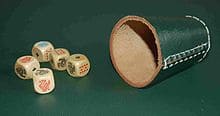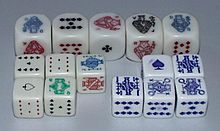



 A set of poker dice and a dice cup
A set of poker dice and a dice cup Three sets of poker dice
Three sets of poker dicePoker dice are dice which, instead of having number pips, have representations of playing cards upon them. Poker dice have six sides, one each of an Ace, King, Queen, Jack, ten and nine, and are used to form a poker hand.
The classic poker dice game is played with 5 dice and two or more players. Each player has a total of 3 rolls and the ability to hold dice in between rolls. After the three rolls the best hand wins. Neither a "flush" nor a "straight flush" is a possible hand, due to the lack of suits on the dice. (Each variety of poker dice varies slightly in regard to suits, though the ace of spades is almost universally represented. 9♣ and 10♦ are frequently found, while face cards are traditionally represented not by suit but instead by color: red for kings, green for queens and blue for jacks. Manufacturers have not standardized the colors of the face sides.)
Marlboro once marketed a set of octahedral poker dice that included suits; each die had slightly different numberings, ranging from 7 up to ace. A similar set are currently manufactured by Koplow Games.
In 1974 Aurora produced a set of 12 sided poker dice called "Jimmy the Greek Odds Maker Poker Dice" and in 2000 Aurora/Rex Games produced a similar set under the name "Royal Poker Dice". The sets featured 5 12 sided dice allowing for all 52 playing cards to be represented. The remaining 8 faces featured stars and acted as wild cards allowing for every possible poker hand to be rolled.
The poker dice hand rankings and the corresponding probabilities of rolling that hand are as follows (not sorted by probability but from highest to lowest ranking):
| Hand | Exact probability | Percentage | 1 in ... | Example |
|---|---|---|---|---|
| Five of a kind | 6 / 7776 | 0.08% | 1296 | J J J J J |
| Four of a kind | 150 / 7776 | 1.93% | 51.8 | 10 10 10 10 A |
| Full house | 300 / 7776 | 3.86% | 25.9 | K K K 9 9 |
| Straight | 240 / 7776 | 3.09% | 32.4 | A K Q J 10 |
| Three of a kind | 1200 / 7776 | 15.43% | 6.5 | 9 9 9 K J |
| Two pair | 1800 / 7776 | 23.15% | 4.3 | Q Q 9 9 A |
| One pair | 3600 / 7776 | 46.30% | 2.2 | 10 10 K Q 9 |
| Bust (High card, no pair, no straight) | 480 / 7776 | 6.17% | 16.2 | A K Q J 9 |
Busts are much lower probability than in card poker, because there are only 6 values instead of 13, making pairs and straights much more likely than with cards. In poker dice there are in fact only four possible bust hands: [A K Q J 9], [A K Q 10 9], [A K J 10 9], and [A Q J 10 9]; both other no-pair hands (i.e., in which either the A or the 9 are missing) are straights. Consequently, in some variants of the rules, straights are counted as busts.